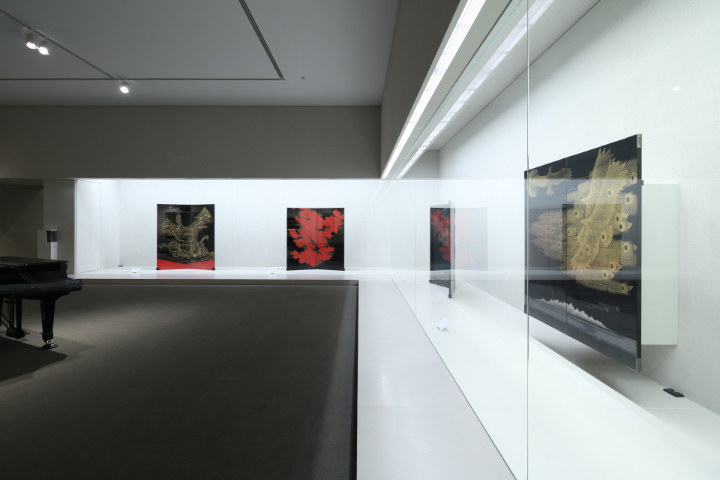
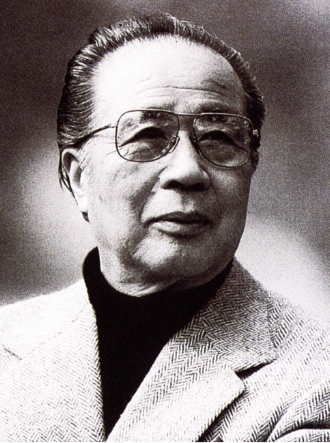
TAKAHASHI Setsuro (1914-2007)
[Audio Guide]
Takahashi Setsuro was born 1914 in Nagano Prefecture. He learned lacquer craft in the Tokyo School of Fine Arts (current Tokyo Geijutsu University), and is known for creating new expressions through his creative career of 70 years.
At first, Takahashi shows prominence through work that uses vivid colored lacquer. After experimenting different methods, he completes his fantastic world of an elegant black lacquer and “Soh-Kin”(gold engravings) which is a craft unique to Takahashi. He created large works such as folding screens, panels, and even sculptural works in his latest years. He was also fluent in ink paintings and calligraphy, and left a wide variety of work until his death in 2007. Takahashi’s work, combining traditional lacquer craft with a free and modern style is appreciated around the world. In 1997, he was awarded the order of Cultural Merit.
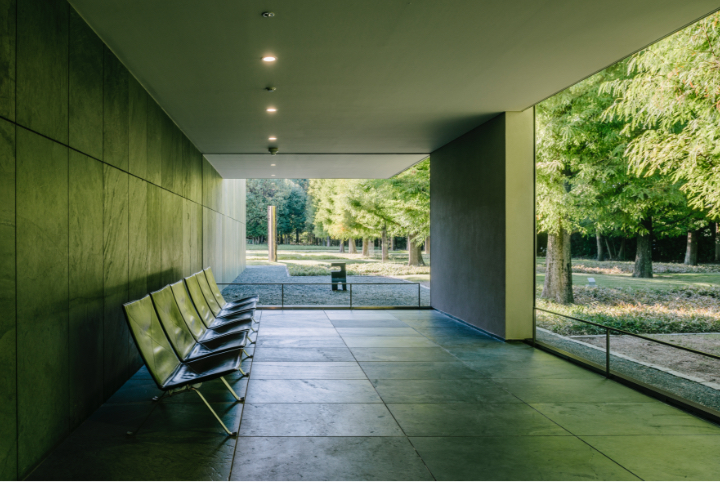
[Audio Guide]
After holding a solo exhibition in Toyota city in 1984, many of Takahashi Setsuro’s works were donated to Toyota city from the artist himself. The “Setsuro Taniguchi Gallery” opened in 1995, along with the Toyota Municipal Museum of Art, both designed by architect Yoshio Taniguchi. It is one of the few museums that focus on a single lacquer artist, and holds a permanent exhibition.
The two gallery rooms center around folding screens and panels where Taniguchi’s “Soh-Kin” technique can be observed, and also exhibits ink paintings and lacquer engravings. Visitors will also encounter musical instruments, such as a grand piano and harp, that have been decorated with gold, silver, and mother-of-pearl work. The Gallery also holds a lounge where visitors can enjoy the seasonal views, and a workshop room.
Soh-Kin
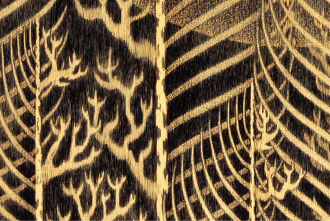
[Audio Guide]
The black and gold pattern seen in the folding screen and panel works, sometimes strong and sharp, and again sometimes very subtle and sensitive, is created by a technique unique to Takahashi, called “Soh-Kin”. “Soh-Kin” is a technique that uses a black lacquer surface as a canvas, and engraves gold or platinum into the lacquer, using sharp tools. The lines are of course, once carved, irreversible. The technique brings a rich quality to the screen. Folding Screens
Byo-bu
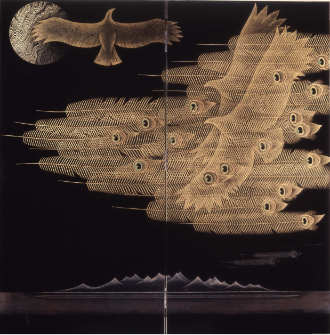
The Genesis of a Constallation, 1975
[Audio Guide]
Takahashi Setsuro engraved fantastic images into the black surface of folding screens and panels. The mountains and stars from his childhood, grand images of nature, and fossils and tombs that calls upon our admiration of ancient times. Takahashi called folding screens “moving murals”, since they are so easily transported and exhibited in any site.
The exhibition cases in the Takahashi Setsuro Gallery can open the panes 180 degrees, and exhibit them as if they are floating in mid-air. The fantastic imagery of the folding screens that consist of golden suns and moons and massive birds covering the sky is emphasized even stronger.
Doji-Shin (Child God)
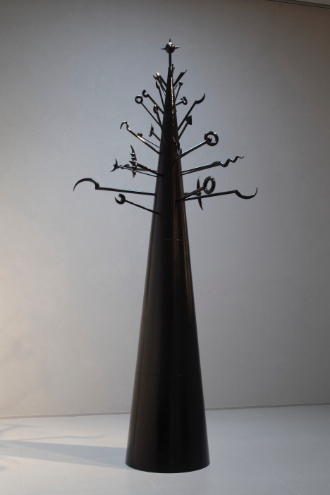
Deity of the Children, 1995
[Audio Guide]
“Child God” which is under permanent exhibition in the Takahashi Setsuro museum, is Takahashi’s largest wood-based dry lacquer work. The plot where the Toyota Municipal Museum of Art – including the Takahashi Setsuro Gallery – stands, was originally home to Doji-Yama elementary school, the oldest school in the history of the city. Takahashi used the actual pillars and beams used in the school building, to create “Doji-Shin” in an image of Sahasrabhuja, to celebrate the transferring elementary school’s children and alumni. The work is a symbol of prayer that the children grow healthily with high ideals, strong bravery, and a kind heart.
Sculptural Works
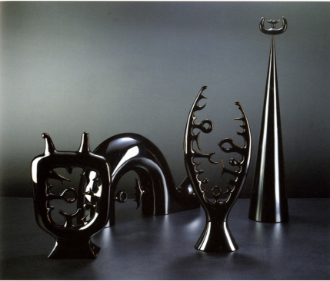
The Eternally Bountiful Earth, 1993
[Audio Guide]
Takahashi’s sculptural works were created after the age of 80. Takahashi says that these works were born from his inner images, and many resemble Takahashi’s fascination with his homeland’s mountains and forests, stimulating the viewer’s imagination. In the Takahashi Setsuro Gallery, Takahashi’s largest wood-based dry lacquer work “Doji-Shin”(Child God) is on permanent exhibit. The Gallery is also surrounded by stone sculptures such as “Getsumen-Ippo”(One step on the moon) which is a work based on the astronauts of Apollo 11 landing on the moon, and “Doji-Ba”(Child Horse).
Instruments
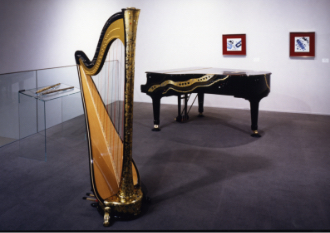
[Audio Guide]
Eternal beauty and harmony is one of Takahashi’s starting points of artistic inquiry. A lover of music, Takahashi aimed to express the beauty and harmony of the universe by decorating instruments with black lacquer, gold, silver, and mother-of-pearl work.
In 1995, the year the Takahashi Setsuro Gallery opened, “Uchu-Kiko”(Space Travel), the grand piano which was his first decorated instrument was finished. Between 1999 and 2005, the harps “Ginga-Kyoso”(Universe Orchestra), the flutes “Kinga”(gold-verse)
“Ginga”(universe/silver-verse), the clarinets “Vega” “Altair” were created. Several times a year, a concert using these instruments are held. “Vega” and “Altair” are also known as “Princess Orihime” and “Prince Hikoboshi” in the Chinese “Tanabata” folklore.
Lacquer Engravings
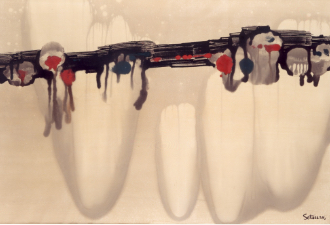
Eclipse, 1975
[Audio Guide]
Takahashi Setsuro has left a number of “lacquer engravings”, which are engravings which use lacquer instead of ink. Organic patterns drawn on glass or stone panels are pressed with wooden or hard-paper letterpresses, so even though they are engravings, each pressed pattern differs from each other.
The lacquer engravings are mainly from the 1950’s and 60’s, a time when Takahashi was experimenting, searching for new possibilities for lacquer. This leads to his later unique expressive world.
Ink Paintings
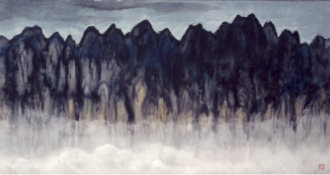
High Peaks, 1989
[Audio Guide]
Takahashi, born in Nagano prefecture, often drew his homeland’s mountains, or landscapes he witnessed through travel, in Kyoto or Nara. It is said that while enrolled in the Tokyo School of Fine Arts (the current Tokyo Geijutsu University), Takahashi was inspired by Japanese style painters such as Kanzan Shimomura and Taikan Yokoyama, and was captured by the magic of Ink paintings. Lacquer is a continuum of very sensitive and intense work, where making corrections is not easy. Ink paintings where one can brush as they please, is said to have been a refreshing activity for Takahashi.
Craft
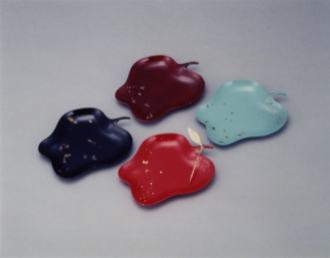
Golden Delicious Plate, 1953
[Audio Guide]
After the second world war, “The Craft Movement” occurred within the craft world that was searching for a new role between art in industrialism. Takahashi Setsuro also created a group with spirited craftspeople and designers, and aimed to “Raise the quality of design in fields of industry, while heading towards a free creativity with craft materials”. Takahashi cutted out metal plates that were left over from manufacturing oil drums, burned chemical paint into them, and designed daily items with a vivid color, suited for a new era. He also collaborated with the Sogetsu group, a branch of modern flower arrangements, and designed wooden flower vases.